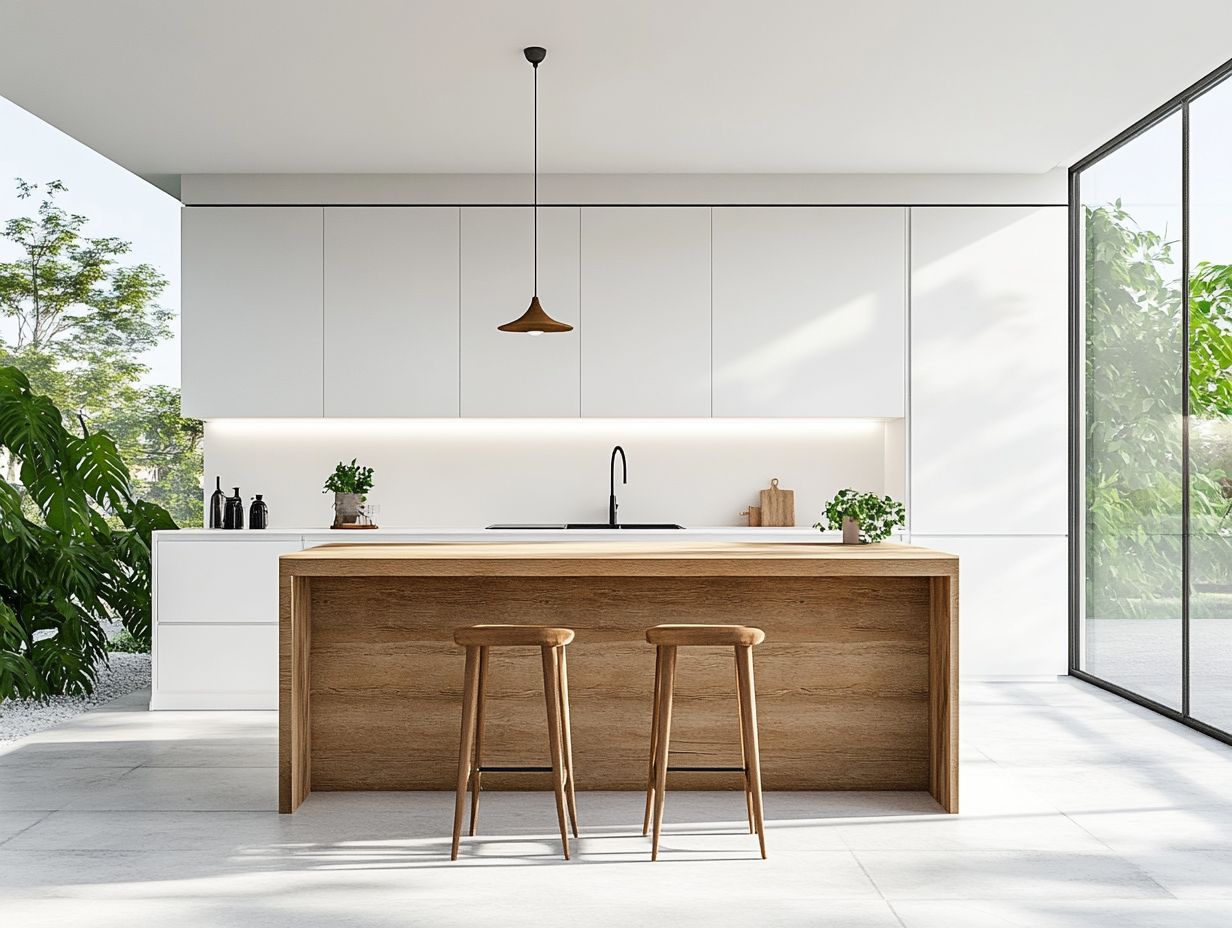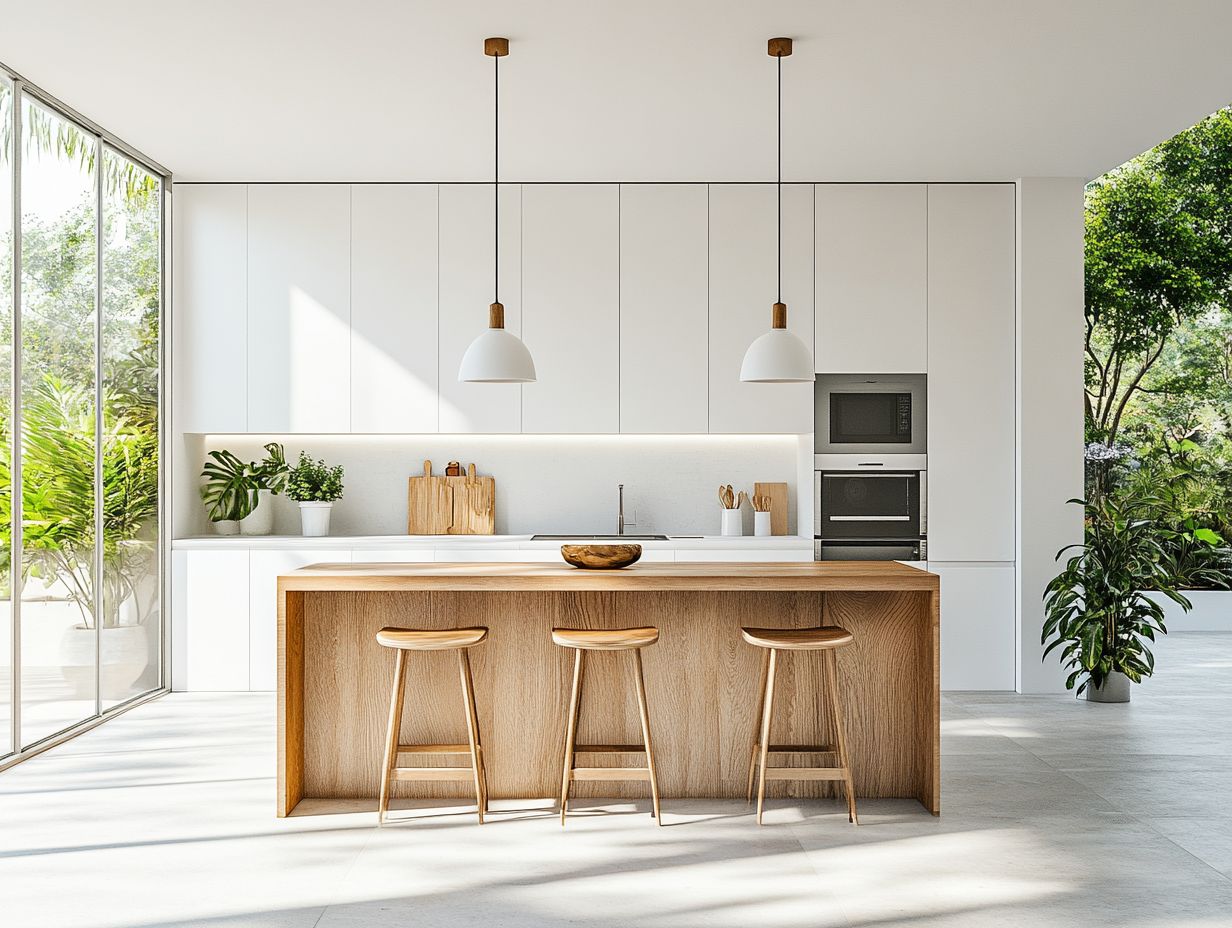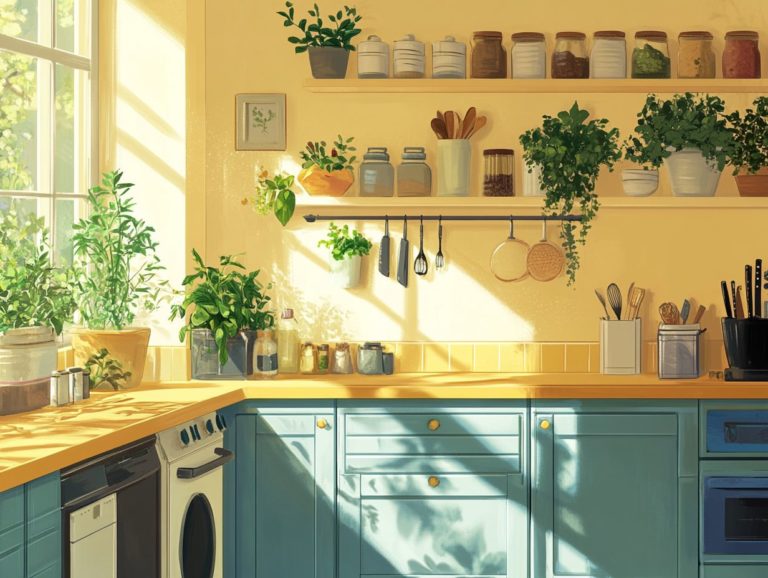5 Inspiring Minimalist Kitchen Ideas
A simple and functional kitchen can transform your cooking space. It can also enhance your overall lifestyle.
Discover five minimalist kitchen ideas. These tips will help you achieve a clean and uncluttered look.
By decluttering, letting in more sunlight, selecting multifunctional furniture, and using a neutral color palette, you’ll find essential tips that elevate both style and efficiency.
Discover how to incorporate sustainability, creative storage solutions, and personal touches without sacrificing the minimalist vibe. Are you ready to simplify your kitchen? Let’s get started!
Contents
- Key Takeaways:
- 1. Declutter and Simplify
- 2. Utilize Natural Light
- 3. Incorporate Multifunctional Furniture
- 4. Stick to a Neutral Color Palette
- 5. Invest in Quality Appliances
- How Can Minimalism Improve Your Kitchen?
- What Are the Key Elements of a Minimalist Kitchen Design?
- How Can You Incorporate Sustainability into Your Minimalist Kitchen?
- What Are Some Creative Storage Solutions for a Minimalist Kitchen?
- How Can You Add a Personal Touch to Your Minimalist Kitchen?
- What Are Some Common Mistakes to Avoid When Designing a Minimalist Kitchen?
- Frequently Asked Questions
- What are some key principles of minimalist kitchen design?
- How can I incorporate natural elements into my minimalist kitchen?
- What color palette works best for a minimalist kitchen?
- How can I make the most of limited space in a minimalist kitchen?
- What are some ways to add personality to a minimalist kitchen?
- Are there any benefits to having a minimalist kitchen?
Key Takeaways:

Minimize clutter and simplify your kitchen to create a clean and organized space.
Utilize natural light to brighten up your space and create a more open and airy feel.
Incorporate multifunctional furniture to maximize space and add versatility to your kitchen design.
1. Declutter and Simplify
Decluttering and simplifying your kitchen is the foundation of minimalist design. This creates a serene atmosphere that elevates both functionality and aesthetics.
This approach allows your space to feel open and inviting. It also provides efficient storage solutions and minimizes visual clutter.
To achieve this balance, evaluate your current cabinetry and accessories. Ensure that only the essentials remain visible.
Utilizing open shelving can greatly enhance the sense of airiness. It makes your kitchen appear larger while showcasing beautifully curated dishware or decor.
Organizing items within your cabinetry promotes a cohesive look where every piece serves a purpose without overwhelming your senses.
Embracing simplicity doesn’t mean sacrificing beauty. Incorporating natural textures, like wooden utensils or ceramic containers, adds warmth and character to the space.
By thoughtfully selecting how you display your items, you can create a functional yet aesthetically pleasing workspace that feels effortlessly organized.
2. Utilize Natural Light
Utilizing natural light in your kitchen is crucial for crafting a modern and inviting atmosphere. Clean lines and contemporary design elements come together to enhance the overall warmth and aesthetics of the space.
Incorporating large windows and skylights allows sunlight to flood in. This makes your kitchen feel open and airy.
These features not only highlight the beauty of your design but also uplift the mood of anyone who spends time in this key area of your home.
Reflective surfaces can amplify natural light even more. They create a bright environment that encourages creativity and productivity.
Research shows that exposure to natural light positively impacts well-being. It makes for a more enjoyable cooking experience and ignites inspiration in your culinary endeavors.
3. Incorporate Multifunctional Furniture
Incorporating multifunctional furniture into your kitchen design allows you to maximize efficiency while embodying the principles of minimalism. This approach provides practical solutions that enhance simplicity without compromising style.
Take an expandable dining table, for instance. It can effortlessly transform from an intimate setting for two into a grand table for entertaining guests, adapting your space to meet your needs.
Similarly, consider islands with built-in storage. They offer extra countertop space while cleverly concealing kitchen essentials, significantly reducing clutter.
The flexibility these pieces bring encourages you to experiment with creative layouts. You can personalize your environment with ease.
Clever design is essential here, ensuring that your furnishings are not only visually appealing but also serve multiple purposes. This ultimately elevates both functionality and aesthetics in your daily life.
4. Stick to a Neutral Color Palette

Sticking to a neutral color palette is crucial in minimalist kitchen design. It creates a backdrop that exudes warmth and elegance, allowing beautiful accents and textures to shine without overwhelming the space.
This subtle choice creates a serene atmosphere and serves as a versatile canvas for incorporating a variety of finishes. By playing with different textures—like matte cabinetry paired with glossy tile—you introduce depth, enhancing visual interest across surfaces.
Thoughtfully integrating contrasting or monochromatic elements can elevate the personality and charm of your kitchen. A bold fruit bowl or a striking pendant light can serve as focal points, ensuring the overall aesthetic remains cohesive while unique character emerges, making the space inviting and a true reflection of your personal style.
5. Invest in Quality Appliances
Investing in quality appliances is essential for your minimalist kitchen design. High-performance tools enhance functionality and efficiency while infusing contemporary elegance that elevates the overall aesthetic of your space.
Choosing appliances that prioritize energy efficiency not only ensures that your kitchen looks stunning but also operates sustainably, significantly reducing its environmental impact.
Opting for items with a cohesive design creates a harmonious flow, making your kitchen feel more inviting and thoughtfully curated. Long-term durability is another critical consideration, as selecting appliances that withstand daily use saves you both time and money.
Make mindful choices that transform your kitchen into a beautiful and practical space you’ll love!
How Can Minimalism Improve Your Kitchen?
Minimalism can transform your kitchen into an organized oasis, where efficiency and functionality reign supreme. This approach invites a sense of calm and clarity, enhancing both the aesthetic and practical aspects of your daily cooking and gatherings.
Embracing a minimalist mindset improves your workflow dramatically. With everything having its designated place, you’ll spend far less time rummaging for utensils or ingredients.
Picture sleek countertops devoid of clutter; this not only streamlines the cooking process but also makes cleaning a breeze.
As you reduce visual clutter, your kitchen evolves into a serene sanctuary that captivates rather than overwhelms, nurturing your creativity and focus. This intentional design invites you to curate your decor with care, selecting only items that hold true meaning and resonate with your lifestyle.
Consider incorporating techniques like pull-out drawers for utensils or open shelving for frequently used spices. These elements exemplify the minimalist philosophy, ensuring everything remains easily accessible while maintaining a tidy and sophisticated appearance.
What Are the Key Elements of a Minimalist Kitchen Design?
- Simplicity and functionality.
- Clean lines that craft an inviting environment.
- Flat-panel cabinetry to maintain an uncluttered look.
- Neutral palettes—whites, grays, and muted hues—to promote a sense of calm.
- Surface materials like smooth wooden surfaces, quartz countertops, and stainless steel appliances that provide durability and visual appeal.
Renowned designer Abby Wolner frequently demonstrates how sleek cabinetry can elevate a space, while Jay Wilde underscores the value of natural light, using glass elements to foster transparency and openness.
Together, these components work harmoniously to embody the essence of minimalist design.
How Can You Incorporate Sustainability into Your Minimalist Kitchen?

Incorporating sustainability into your minimalist kitchen does more than just align with modern design principles. It promotes eco-friendly practices that enhance functionality while minimizing your environmental impact.
By choosing sustainable materials like bamboo cabinetry or recycled countertops, you can achieve a sleek look without sacrificing durability. Energy-efficient appliances cut down on energy consumption and blend seamlessly into your overall aesthetic.
Practices such as recycling and composting create a more organized and responsible space. These elements work together, creating an inviting environment that showcases your commitment to simplicity and sustainability.
What Are Some Creative Storage Solutions for a Minimalist Kitchen?
Creative storage solutions are essential for maintaining organization in a minimalist kitchen. They help create a clutter-free environment that showcases functionality while maximizing available surfaces and cabinetry.
Incorporating pull-out shelves significantly enhances accessibility, making it easy to reach forgotten items hidden away in the back. Drawer organizers can transform chaotic utensil drawers into beautifully arranged compartments.
Vertical storage options, like wall-mounted racks or open shelves, let you take full advantage of wall space, showcasing stylish cookware while keeping your countertops clear.
Together, these innovative ideas streamline your kitchen tasks and create a cohesive atmosphere, ensuring that each element is functional and visually pleasing.
How Can You Add a Personal Touch to Your Minimalist Kitchen?
Adding a personal touch to your minimalist kitchen infuses character and warmth into the space. It’s about reflecting your unique personality while adhering to the principles of simplicity.
You can achieve this by selecting unique accessories that spark joy, like handcrafted pottery or chic kitchen tools that blend with your aesthetic.
Incorporating art pieces that resonate with you, such as a framed print or small sculpture, personalizes your environment without cluttering it.
Consider subtle color accents through textiles like dish towels or small decor items. These can enhance the space while maintaining a cohesive look, creating an inviting atmosphere that feels distinctly yours.
What Are Some Common Mistakes to Avoid When Designing a Minimalist Kitchen?
Avoiding common mistakes is key to creating your dream kitchen. Oversights can lead to unnecessary visual clutter and compromise design integrity.
One frequent pitfall is using too many accessories, which can quickly turn your sleek space into chaos. Focus on selecting a few high-impact items that genuinely add value.
Misjudging your storage needs can result in insufficient space for essentials, creating disorder in what should be a serene environment. Implement smart storage solutions, such as hidden compartments and multifunctional furniture, to address this without sacrificing style.
Lighting is another often-overlooked aspect, yet it plays a vital role in creating an inviting atmosphere. By incorporating layered lighting—ambient, task, and accent—you enhance both functionality and the minimalist aesthetic.
Frequently Asked Questions

What are some key principles of minimalist kitchen design?
The key principles of minimalist kitchen design include simplicity, functionality, and organization. Minimalist kitchens often have clean lines, limited use of color, and a focus on essential items rather than clutter.
Ready to start your minimalist kitchen journey? Share your thoughts below!
How can I incorporate natural elements into my minimalist kitchen?
Incorporate natural elements by using materials like wood, stone, and metal. These materials add warmth and texture to a simple design and using plants or herbs brings in a refreshing touch of greenery.
What color palette works best for a minimalist kitchen?
Neutral colors such as white, black, and grey work wonderfully in minimalist kitchens. They create a clean, timeless look and can make your space feel larger.
Add a vibrant splash of color with striking accent pieces for a stunning effect!
How can I make the most of limited space in a minimalist kitchen?
Maximize storage by using furniture that serves more than one purpose, like a kitchen island with built-in storage. Use vertical space with shelves or hanging racks and keep countertops clutter-free for a spacious feel.
What are some ways to add personality to a minimalist kitchen?
Even with a minimalist design, you can add personality. Display a few statement pieces, like a unique light fixture or artwork, for a personal touch.
Small details, such as fun cabinet knobs or a distinctive backsplash, can also bring character to your kitchen.
Are there any benefits to having a minimalist kitchen?
Absolutely! A minimalist kitchen makes meal prep and cooking easier by reducing clutter and distractions. It creates a peaceful, calming environment and saves time and money by cutting down on excess items and maintenance.





